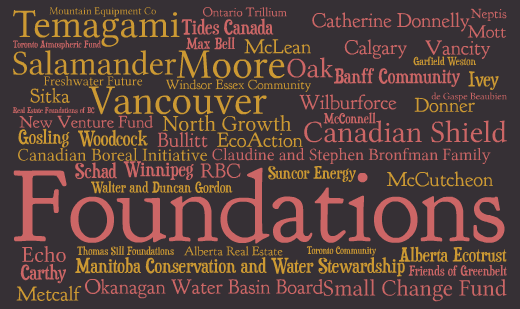
Canada’s grant-giving foundations played a seminal role in the origins of Canada’s environmental movement.
Canada’s grant-giving foundations have not only supported the arts and education, medical research and social causes. They also played a seminal role in the origins of Canada’s environmental movement. Our guests in this story reveal the hidden face of philanthropy and the part it played in the growth of the environmental movement in Canada.
It all started with endangered spaces and species. During the 1960s and 70s, a number of Canadian charitable foundations were actively involved in conservation and land preservation work, providing substantial funds to the Nature Conservancy of Canada, the Federation of Ontario Naturalists and similar groups to buy key parcels of Canada’s natural heritage to protect them from development. There were also funds for assembling properties for future parkland, and protecting iconic endangered species.
Foundations (in Canada) are charities that either undertake their own activities or fund others from the endowments contributed by wealthy individuals, families, corporations or communities. They receive funding from a variety of arm's length donors while the bulk of the funding of a private foundation comes from a person or group of people that control the charity.
Fifty years ago, the major foundations active in the conservation field were, primarily, family run. While their generous (and much needed) donations reflected the personal passions of those families, they did not tend to challenge the land use decisions that were converting Canada’s greenspace and farmland into sprawling subdivisions.
By the 1970s, times were changing. Several funders had begun to kick start the advocacy and reform work that became the hallmark of the young environmental movement. The Ivey Foundation donated the first $25,000 to get Pollution Probe off the ground. The McLean Foundation funded the Innu’s fight against low-level jet training by the Canadian military over Labrador. A number of foundations – including the Laidlaw, Gordon and McLain foundations – were funding organizations active in Arctic resource development issues. They also helped First Nations and environment groups prepare their expert cases before the Mackenzie Valley pipeline inquiry.
“[Through the 1980s,] environmental grant-giving was a mostly haphazard, ad hoc use of funds … The money ended up, in [too] many cases, in the wrong places at the wrong time.”By the 1990s two things were becoming clear. First, environmental groups desperately needed more (and more sustainable) funding to maintain their advocacy work, especially in the face of austerity-minded and business-friendly governments busy rolling back their environmental programs. And second, the foundations needed to start working together in order to make their donations more strategic and much more effective. It was becoming increasingly difficult to see how all the individual grants fit into the larger picture. In 1995, representatives from a dozen foundations initiated the idea of a network of Canadian environmental grantmakers that would collaborate, share knowledge and work together to build an environmentally sound and sustainable future for Canadians. The Canadian Environmental Grantmakers’ Network (CEGN) opened an office in October 2000, and incorporated federally as a not-for-profit organization in 2001. Canadian foundations also supported the Sustainability Network to help environmental groups and other non-profits improve their management, leadership and organizational skills. Over the last ten years, foundations have been a central force in resurrecting a series of progressive land use initiatives. Sparked by the Walkerton drinking water tragedy, provincial governments began to reconsider their slash-and-burn approach to environmental protection. First, the Harris government brought in legislation to safeguard the Oak Ridges Moraine from urban development. Then, the McGuinty government, backed by the solid research and an extremely effective public relations campaign prepared by a coalition of environmental groups, brought in legislation to protect more than one million additional acres in a Greenbelt that extends from the Niagara Escarpment through the Moraine lands and north to the shores of Lake Simcoe.
“The foundations all brought not only money, but a spirit of wanting to get something done.Today, foundations and funding programs are more important than ever, creating coalitions, forging partnerships, bringing new ways of thinking to the evolving environmental issues of the new millennium. Targeted donations are helping spark the green economy and building bridges between health professionals and environmentalists looking at the insidious impacts of toxics in the environment. The CEGN has grown to represent more than 65 private, community, public and corporate foundations, as well as government and corporate funding programs that provide over $50 million in environmental grants across Canada each year. Governments and large corporations have set up a number of funding projects to support environmental programs and objectives. For more information, see the Canada Revenue Agency webpage. For more information on many of Canada’s environmental grantmakers, visit the CEGN website at http://www.cegn.org.
